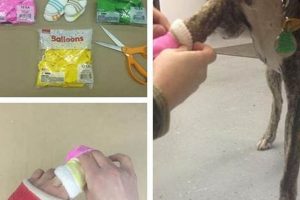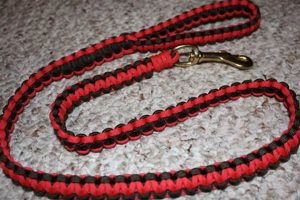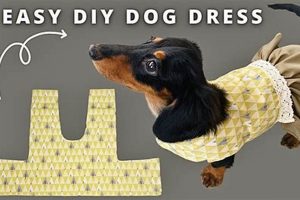The crafting of homemade canine cleansing solutions involves the combination of readily available household ingredients to create a product designed for washing dogs. This approach allows for customized formulations, often utilizing gentle components such as oatmeal, baking soda, and mild soaps. For instance, a mixture of water, castile soap, and a few drops of essential oils (safe for canine use) can serve as a basic formulation.
Creating custom washes offers advantages including control over ingredients, making it suitable for dogs with sensitivities or allergies. Additionally, this practice can be a cost-effective alternative to commercially available shampoos. The historical context reveals a long-standing tradition of pet owners formulating their own remedies, driven by concerns about potentially harsh chemicals in mass-produced products and a desire for natural alternatives.
The subsequent sections will explore various recipes, safety considerations, application techniques, and storage recommendations for these personalized canine hygiene products. Further discussion will address potential risks and alternatives, providing a comprehensive guide for individuals considering this approach to pet care.
Tips for Crafting Homemade Canine Cleansing Solutions
The following guidelines offer practical advice for creating effective and safe homemade washes for dogs. Adherence to these recommendations contributes to a positive grooming experience and minimizes potential adverse reactions.
Tip 1: Ingredient Selection: Prioritize gentle, non-toxic components. Castile soap, known for its mildness, is a suitable base. Avoid ingredients containing artificial fragrances, dyes, or harsh detergents.
Tip 2: Patch Testing: Before full application, conduct a patch test on a small area of the dog’s skin. Observe for 24-48 hours for any signs of irritation, such as redness, itching, or inflammation.
Tip 3: Dilution is Key: Concentrated solutions can be irritating. Dilute the mixture with water according to the specific recipe. A general guideline is to dilute the solution until it reaches a watery consistency.
Tip 4: Essential Oil Caution: Exercise extreme caution when using essential oils. Many are toxic to dogs. If used, ensure they are canine-safe and highly diluted (less than 1% concentration). Consultation with a veterinarian is recommended.
Tip 5: Avoid Sensitive Areas: Prevent the mixture from entering the dog’s eyes, ears, and mouth. Utilize a damp cloth to cleanse the face, avoiding direct application of the solution.
Tip 6: Thorough Rinsing: Residual soap can cause skin irritation. Ensure thorough rinsing with lukewarm water until all traces of the wash are removed. A squeaky-clean coat indicates adequate rinsing.
Tip 7: Proper Storage: Store any unused solution in a clearly labeled container in a cool, dark place. Discard the mixture after one week to prevent bacterial growth, especially if it contains perishable ingredients.
Effective and safe homemade canine washes hinge on careful ingredient selection, proper dilution, and thorough rinsing. Prioritizing the dog’s well-being throughout the process is paramount.
The subsequent section will address potential issues arising from the utilization of these methods and provide guidance on when to seek professional veterinary assistance.
1. Gentle Ingredients
The selection of gentle ingredients is paramount when formulating homemade canine cleansing solutions. Given the potential for skin irritation and allergic reactions in dogs, careful consideration of each component is essential for producing a safe and effective product.
- pH Balance Considerations
Canine skin exhibits a pH balance different from that of human skin. Formulations should aim to maintain this natural balance, typically around 7.0, to avoid disrupting the skin’s protective acid mantle. Ingredients with extreme pH levels can lead to dryness, itching, and increased susceptibility to infection. For example, excessive use of baking soda, while a common ingredient, can elevate pH and cause irritation.
- Soap Selection and Alternatives
Traditional soaps can strip the skin of its natural oils, leading to dryness and discomfort. Castile soap, derived from vegetable oils, is often recommended due to its mildness. Soap-free alternatives, such as certain plant-based cleansers, offer another option for minimizing irritation. However, even these alternatives should be used in diluted form to prevent over-cleansing.
- Soothing Additives
Ingredients with soothing properties can help mitigate potential irritation and promote skin health. Oatmeal, for instance, possesses anti-inflammatory and moisturizing qualities, making it beneficial for dogs with sensitive skin. Aloe vera gel can also provide a soothing effect, although its use should be limited due to potential laxative effects if ingested during grooming.
- Avoidance of Harsh Chemicals and Irritants
Many commercially available shampoos contain harsh chemicals, such as sulfates, parabens, and artificial fragrances, which can be detrimental to canine skin health. Homemade formulations allow for the elimination of these potentially harmful substances. A detailed review of ingredient lists is crucial to ensure that all components are safe and well-tolerated by the dog.
The careful selection and balanced combination of gentle ingredients are critical for producing a canine cleaning solution that minimizes the risk of adverse reactions and supports overall skin health. The benefits of customizing ingredients in homemade formulations allows pet owners to address sensitivities and safeguard canine well-being.
2. Proper Dilution
Proper dilution is a cornerstone of safe and effective homemade canine cleansing solutions. Undiluted or improperly diluted mixtures can lead to skin irritation, chemical burns, and other adverse reactions in dogs, underscoring the critical importance of this step in the formulation process.
- Concentration and Skin Sensitivity
A direct relationship exists between the concentration of the cleaning solution and the potential for skin irritation. Canine skin is generally more sensitive than human skin, and concentrated solutions can strip away natural oils, leading to dryness, itching, and inflammation. For example, undiluted castile soap, while considered a gentle cleanser, can still cause irritation if applied directly to the skin.
- Uniform Distribution and Rinsing Efficiency
Proper dilution ensures a more uniform distribution of the cleansing solution across the dog’s coat. This allows for thorough cleaning and facilitates more effective rinsing. Insufficiently diluted mixtures tend to clump, making complete removal difficult. Residual shampoo can cause skin irritation and attract dirt and debris, negating the benefits of the wash.
- Impact on Ingredient Interaction
Dilution can influence the interaction between various ingredients in the solution. Some ingredients, such as essential oils, can become more potent when concentrated, increasing the risk of adverse reactions. Dilution helps to moderate these interactions, creating a more balanced and safer formula. For instance, an essential oil that is safe at a 0.5% concentration could become irritating or even toxic if applied undiluted.
- Measurement and Application Guidelines
Accurate measurement is essential for achieving proper dilution. Recipes should specify precise ratios of ingredients to water. Graduated cylinders, measuring spoons, and similar tools ensure accuracy. Application techniques also play a role; evenly distributing the diluted solution and avoiding over-saturation are key to minimizing the risk of irritation.
In summary, proper dilution is not merely a procedural step but an integral safety measure in the creation of homemade canine shampoos. By controlling the concentration of the solution, ensuring uniform distribution, and managing ingredient interactions, dilution safeguards the dog’s skin and promotes a positive grooming experience. Adherence to established dilution guidelines is paramount for any individual considering this approach to pet care.
3. Skin Sensitivity
Canine skin sensitivity represents a critical consideration when formulating homemade cleansing solutions. The inherent variability in canine skin types, coupled with the potential for adverse reactions to certain ingredients, necessitates a thorough understanding of this factor to mitigate risks associated with self-made shampoos.
- Breed Predisposition
Certain breeds exhibit a higher predisposition to skin sensitivities. Breeds such as bulldogs, German shepherds, and Labrador retrievers are known to be more prone to allergic dermatitis and other skin conditions. Utilizing homemade formulations without considering breed-specific sensitivities can exacerbate existing conditions or trigger new ones. For instance, a recipe containing potentially allergenic ingredients might be well-tolerated by a poodle but cause significant irritation in a bulldog.
- Allergic Reactions to Common Ingredients
Common ingredients used in crafting homemade shampoos, such as essential oils and certain plant extracts, can act as allergens. Even seemingly benign substances like oatmeal can trigger allergic reactions in some dogs. Reactions can manifest as itching, redness, hives, or even gastrointestinal upset if ingested during grooming. A thorough understanding of potential allergens and careful monitoring of the dog’s reaction to each ingredient is crucial.
- Impact of pH Imbalance
Maintaining an appropriate pH balance is vital for canine skin health. Homemade formulations that are too acidic or alkaline can disrupt the skin’s natural protective barrier, making it more susceptible to infections and irritations. For example, excessive use of baking soda can raise the pH level, leading to dryness and itching. Understanding the pH levels of different ingredients and adjusting the formula accordingly is essential.
- Pre-existing Skin Conditions
Dogs with pre-existing skin conditions, such as seborrhea or eczema, require specialized care. Homemade formulations may not be suitable for managing these conditions and could potentially worsen them. Consulting with a veterinarian or veterinary dermatologist is recommended before using homemade shampoos on dogs with diagnosed skin ailments. Commercially available medicated shampoos are often specifically formulated to address these conditions and may be a safer alternative.
Given the diverse nature of canine skin and the potential for adverse reactions, a cautious and informed approach to homemade cleaning solutions is warranted. Prioritizing gentle, hypoallergenic ingredients, performing patch tests, and monitoring the dog’s skin for any signs of irritation are essential steps. In cases of pre-existing skin conditions or heightened sensitivity, consulting with a veterinary professional is paramount to ensure canine well-being.
4. Thorough Rinsing
The process of thoroughly rinsing a canine’s coat after the application of a self-made shampoo is directly linked to the overall efficacy and safety of such products. Inadequate rinsing allows residual shampoo to remain on the dog’s skin, potentially leading to irritation, dryness, and allergic reactions. The homemade nature of the shampoo further underscores the importance of this step, as these formulations often lack the advanced rinsing agents found in commercially produced options. For instance, a recipe utilizing castile soap, if not completely removed, can leave a sticky residue that attracts dirt and debris, counteracting the intended cleansing effect. This residue can also alter the skin’s pH, disrupting the natural barrier and increasing susceptibility to secondary infections.
Practical application of thorough rinsing involves employing copious amounts of lukewarm water and systematically working through the coat. Emphasis should be placed on areas prone to shampoo buildup, such as the undercarriage, paws, and tail. The visual cue of clear, running water serves as an indicator of sufficient rinsing. Furthermore, physically squeezing the coat and observing the water runoff can confirm the absence of residual shampoo. Dogs with thicker coats may require extended rinsing periods and the use of a high-pressure nozzle to penetrate the dense fur. Failure to adhere to these techniques can result in persistent skin irritation, necessitating veterinary intervention in severe cases.
In conclusion, thorough rinsing is not merely a supplementary step but an essential component of responsible homemade canine shampoo usage. The challenges associated with homemade formulations, particularly the potential for residue buildup, necessitate meticulous rinsing practices. Recognizing the practical significance of this connection safeguards canine well-being and optimizes the benefits of a custom-made cleaning solution. Adherence to proper rinsing protocols is thus a fundamental aspect of ethical and effective pet care.
5. Avoid Eye Contact
The imperative to avoid ocular contact during the application of homemade canine cleansing solutions stems from both physiological and formulation-specific considerations. Canine eyes possess a tear film and corneal structure distinct from those of humans, rendering them more vulnerable to irritation from external substances. Components present in do-it-yourself washes, even those deemed ‘gentle’, may induce discomfort, inflammation, or, in extreme cases, corneal damage upon contact. For example, essential oils, frequently incorporated for fragrance or purported therapeutic benefits, can provoke severe reactions if introduced to the ocular surface. Similarly, even mild soaps can disrupt the delicate pH balance of the tear film, leading to stinging sensations and potential long-term complications. The preventative measure of avoiding eye contact thus acts as a primary safeguard against iatrogenic harm.
Mitigation strategies encompass both direct application techniques and protective measures. During the washing process, tilting the dog’s head upwards can help to redirect water and suds away from the eyes. A damp cloth, rather than direct pouring, should be employed for cleansing the facial region. Furthermore, commercially available ophthalmic lubricants can be administered prior to bathing to provide a protective barrier. In situations where accidental eye contact occurs, immediate and profuse rinsing with clean, lukewarm water is essential. Subsequent monitoring for signs of irritation, such as excessive blinking, redness, or discharge, should be conducted, and veterinary consultation should be sought if symptoms persist or worsen. The absence of such precautions significantly elevates the risk of ocular injury, potentially necessitating medical intervention.
The connection between preventing ocular exposure and the application of custom canine washes represents a crucial intersection of safety and responsible pet care. Recognizing the heightened vulnerability of canine eyes and proactively implementing preventative measures are paramount for minimizing adverse outcomes. The challenges associated with homemade formulations, including the absence of standardized safety testing and potential variability in ingredient quality, further underscore the importance of diligent risk mitigation strategies, with avoiding eye contact serving as a foundational element.
6. Safe Essential Oils
The integration of safe essential oils within the formulation of homemade canine cleansing solutions necessitates a comprehensive understanding of their properties, potential risks, and appropriate application methods. The incorrect use of these substances can result in adverse reactions, undermining the intended benefits of a personalized shampoo.
- Dilution Ratios and Toxicity
Essential oils, in their concentrated form, pose a significant toxicity risk to canines. Their highly concentrated nature requires extreme dilution before topical application. Generally, a dilution ratio of 0.5% to 1% is considered the upper limit of safe usage. For example, lavender oil, often touted for its calming properties, can cause central nervous system depression in dogs if applied undiluted or at excessive concentrations. Precise measurement and adherence to recommended dilution guidelines are therefore crucial.
- Canine-Specific Contraindications
Certain essential oils are inherently toxic to canines, regardless of the dilution. Tea tree oil (melaleuca) is a prime example, as it contains compounds that can cause neurological damage, liver failure, and skin irritation in dogs. Similarly, pennyroyal oil should be strictly avoided due to its potential to induce seizures and liver damage. Before incorporating any essential oil into a shampoo recipe, verifying its safety for canine use through reputable sources is imperative.
- Carrier Oils and Absorption Rates
Carrier oils play a vital role in diluting essential oils and facilitating their safe application. These oils, such as coconut oil, almond oil, or jojoba oil, not only reduce the concentration of the essential oil but also influence its absorption rate. For instance, coconut oil, being a medium-chain triglyceride, is readily absorbed by the skin, potentially increasing the systemic exposure to the essential oil. The choice of carrier oil should be carefully considered based on the desired therapeutic effect and the dog’s skin type.
- Individual Sensitivities and Patch Testing
Even when utilizing essential oils generally deemed safe for canines, individual sensitivities can occur. A patch test should be conducted prior to full-body application. This involves applying a small amount of the diluted essential oil mixture to a discrete area of the dog’s skin and monitoring for any signs of irritation, such as redness, itching, or inflammation, over a 24-48 hour period. The absence of adverse reactions during the patch test does not guarantee complete safety, but it provides a preliminary indication of tolerance.
The safe and responsible integration of essential oils into homemade shampoos hinges on precise dilution, adherence to canine-specific contraindications, informed selection of carrier oils, and diligent monitoring for individual sensitivities. Neglecting these factors significantly elevates the risk of adverse reactions, compromising the well-being of the animal and negating the intended benefits of a customized grooming product.
7. Storage Protocols
Storage protocols for homemade canine cleansing solutions are critical due to the absence of industrial preservatives commonly found in commercially produced products. Improper storage can lead to microbial growth, ingredient degradation, and a diminished efficacy of the wash, potentially harming the animal.
- Container Selection and Material Compatibility
The choice of storage container directly impacts the stability of the homemade shampoo. Opt for opaque, airtight containers made of chemically inert materials such as high-density polyethylene (HDPE) or glass. Avoid using containers made of reactive metals or plastics that can leach chemicals into the solution. Improper container selection can result in alteration of the shampoo’s pH, degradation of essential oils, and even the production of toxic byproducts. For example, storing a citrus-based shampoo in a metal container can lead to corrosion and contamination of the solution.
- Temperature Control and Environmental Factors
Temperature fluctuations and exposure to light and air can accelerate the degradation of natural ingredients. Store homemade shampoos in a cool, dark, and dry environment. High temperatures can promote microbial growth and alter the chemical structure of certain components. Direct sunlight can degrade light-sensitive ingredients like essential oils, reducing their potency and potentially creating harmful compounds. For instance, storing a chamomile shampoo in direct sunlight can diminish its soothing properties and lead to skin irritation.
- Shelf Life Considerations and Expiration Dates
Homemade shampoos lack the preservatives found in commercial products, limiting their shelf life. Generally, a homemade canine shampoo should be used within one to two weeks of preparation. Label the container with the preparation date to ensure timely use. Discard any solution that exhibits signs of spoilage, such as discoloration, separation, or an unusual odor. The use of expired shampoo can lead to skin irritation, allergic reactions, and even bacterial infections.
- Sanitization and Cross-Contamination Prevention
Prior to storing the homemade shampoo, thoroughly sanitize the container and any dispensing tools (e.g., pumps, measuring spoons). Use hot, soapy water followed by a rinse with a diluted bleach solution (1 part bleach to 10 parts water) to eliminate potential contaminants. Avoid cross-contamination by using separate containers and tools for different shampoo formulations. Failure to sanitize storage containers can introduce harmful bacteria or fungi into the shampoo, potentially causing skin infections in the dog.
Adherence to stringent storage protocols is essential for maintaining the safety and efficacy of homemade canine cleansing solutions. The vulnerability of these formulations to microbial contamination and ingredient degradation necessitates careful attention to container selection, temperature control, shelf life, and sanitation. Compromising on these protocols can negate the benefits of using natural ingredients and potentially harm the animal’s health.
Frequently Asked Questions
The following addresses common inquiries and misconceptions concerning the creation and application of do-it-yourself shampoos for dogs, providing detailed, evidence-based responses.
Question 1: Is crafting homemade canine shampoos inherently safer than using commercially available products?
The assertion that homemade shampoos are universally safer is not substantiated. While DIY formulations allow for ingredient control, they lack the rigorous testing and standardization protocols inherent in commercial manufacturing. Potential risks include improper pH balance, ingredient toxicity, and microbial contamination.
Question 2: What are the primary risks associated with improper pH balance in homemade canine shampoos?
Deviations from the optimal pH range for canine skin (approximately 5.5 to 7.5) can disrupt the skin’s acid mantle, increasing vulnerability to bacterial and fungal infections. Alkaline shampoos can cause dryness and irritation, while acidic shampoos may lead to chemical burns.
Question 3: How can microbial contamination be prevented in DIY canine shampoo formulations?
Microbial growth can be minimized by using sterile containers, employing purified water, and storing the shampoo in a cool, dark environment. Due to the absence of synthetic preservatives, homemade shampoos have a limited shelf life, typically one to two weeks, after which they should be discarded.
Question 4: What essential oils are definitively contraindicated for use in canine shampoos?
Certain essential oils, including tea tree oil, pennyroyal oil, and wintergreen oil, are known to be toxic to dogs and should be strictly avoided. Even purportedly safe essential oils can cause adverse reactions in sensitive animals and must be used with extreme caution and appropriate dilution.
Question 5: How can the risk of allergic reactions be minimized when using homemade shampoos?
A patch test should be performed prior to full-body application. Apply a small amount of the diluted shampoo to a discrete area of the dog’s skin and monitor for signs of irritation or allergic reaction for 24-48 hours. Should any adverse effects manifest, discontinue use immediately.
Question 6: When is professional veterinary consultation necessary regarding canine skin care?
Veterinary consultation is recommended for dogs with pre-existing skin conditions, such as dermatitis, allergies, or infections. A veterinarian can provide tailored guidance on appropriate cleansing products and treatment strategies, as homemade shampoos may not be suitable or sufficient in these cases.
The creation and use of homemade canine shampoos necessitate a thorough understanding of potential risks and benefits. While offering customization options, these formulations require meticulous attention to detail to ensure the safety and well-being of the animal.
The subsequent section will provide a summary of key recommendations and concluding remarks regarding the formulation and application of DIY canine cleansing solutions.
DIY Shampoo for Dogs
This exploration has illuminated the complexities surrounding the formulation and application of diy shampoo for dogs. While the allure of customized ingredients and cost-effectiveness may appeal to pet owners, the potential for adverse reactions, pH imbalances, and microbial contamination necessitates a cautious and informed approach. Prioritizing canine well-being through meticulous ingredient selection, proper dilution, and adherence to strict storage protocols remains paramount.
Given the inherent risks associated with formulating canine cleansing solutions, pet owners are urged to carefully weigh the potential benefits against the potential harm. When in doubt, seeking guidance from a qualified veterinary professional is strongly advised. The long-term health of the animal must always supersede the desire for cost savings or perceived natural alternatives. The future of canine hygiene lies in evidence-based practices, whether through commercially available products or carefully researched and executed homemade formulations.







